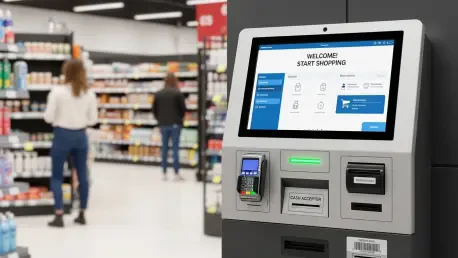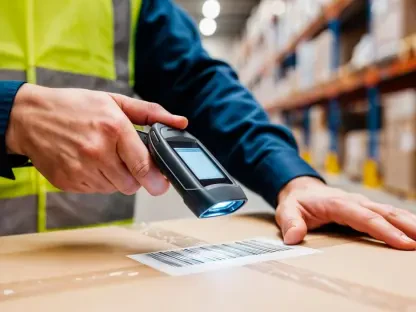Setting the Stage for Retail Transformation
In an era where speed and convenience dominate consumer expectations, retail environments are grappling with a staggering statistic: nearly 70% of shoppers abandon long checkout lines due to frustration over wait times, highlighting the urgent need for innovative solutions. This growing impatience, coupled with persistent labor shortages and rising operational costs, has pushed retailers to seek transformative technologies. Self-service kiosks have emerged as a promising solution, revolutionizing how transactions are processed and customer experiences are shaped. These standalone systems are not just tools for automation but represent a shift toward balancing efficiency with personalized service in high-volume settings.
This review delves into the core capabilities of self-service kiosks, examining their impact across retail and hospitality sectors. By exploring their features, real-world performance, and the challenges they face, a comprehensive picture of their role in modern retail technology unfolds. The focus is on how these systems address pressing industry needs while adapting to evolving consumer behaviors, setting the stage for a deeper understanding of their significance.
Unpacking the Features and Performance
Streamlining Transactions for Maximum Efficiency
Self-service kiosks stand out for their ability to accelerate transactions, significantly cutting down wait times in busy retail environments. Whether in a bustling superstore or a fast-paced food outlet, these systems allow customers to complete purchases or access services like event ticketing with minimal delay. Their design prioritizes user-friendly interfaces, ensuring that even less tech-savvy individuals can navigate payment processes effortlessly, which boosts overall satisfaction.
Beyond speed, kiosks excel in queue management, a critical factor in high-volume settings across the US. By automating routine tasks such as scanning items or processing payments, they reduce the burden on staff, enabling smoother operations during peak hours. Real-world data from major retail chains highlights a marked improvement in throughput, with some locations reporting up to a 30% reduction in average checkout times since deployment.
The efficiency of these systems also extends to error reduction in transactions. Unlike manual processes prone to human mistakes, kiosks ensure accuracy in pricing and inventory updates, fostering trust among customers. This reliability positions them as indispensable tools for retailers aiming to maintain competitiveness in a fast-moving market.
Harnessing Advanced Technology for Personalization
A standout feature of modern self-service kiosks is their integration with cutting-edge technologies like artificial intelligence and customer relationship management systems. These integrations enable real-time personalization, tailoring product recommendations based on past purchases or browsing habits. Such capabilities transform a simple transaction into a curated shopping experience, enhancing customer engagement.
Additionally, connectivity with inventory management systems ensures that kiosks provide accurate stock information, preventing frustrations over unavailable items. Retailers benefit from the operational insights these systems offer, allowing for better demand forecasting and resource allocation. This synergy between technology and functionality elevates the kiosk from a mere checkout tool to a strategic asset.
Examples from leading retail brands showcase how technology-driven interactions improve outcomes. For instance, some stores use AI-powered kiosks to suggest complementary products during checkout, increasing upsell opportunities without requiring staff intervention. This seamless blend of automation and insight underscores the potential for kiosks to redefine customer interactions.
Adapting to Diverse Industry Applications
The versatility of self-service kiosks shines through in their varied applications across industries. In retail superstores, they serve as interactive mapping tools, guiding customers through sprawling aisles, while also functioning as self-checkout stations. This dual role minimizes the need for constant staff assistance, optimizing workforce allocation.
In the hospitality sector, kiosks manage check-ins and basic guest services, freeing up personnel to focus on more nuanced, personal interactions. Hotels leveraging this technology report higher guest satisfaction, as staff can dedicate time to addressing unique needs rather than routine tasks. This balance of automation and human touch proves essential in maintaining service quality.
Parallels can be drawn with other sectors, such as online casinos, where virtual dealer interactions via live-streaming technology mirror the kiosk model. Here, automation scales operations while preserving an element of personal engagement, illustrating how technology can complement rather than replace human roles. Such cross-industry insights highlight the adaptability of kiosk systems to diverse operational challenges.
Navigating Challenges in Deployment
Technical and Maintenance Hurdles
Despite their advantages, self-service kiosks come with notable technical challenges. Integrating these systems with existing store infrastructure often proves complex, requiring significant updates to software and hardware. Retailers must ensure compatibility with payment gateways and inventory databases, a process that can delay implementation.
Maintenance demands further complicate adoption. Regular updates and troubleshooting are necessary to prevent downtime, which can frustrate customers and disrupt operations. For smaller retailers, the lack of in-house technical expertise exacerbates these issues, often necessitating costly external support to keep systems running smoothly.
Customer Resistance and Usability Concerns
Another barrier lies in customer acceptance of automated systems. While many embrace the speed of kiosks, a segment of shoppers still prefers human interaction, especially for complex transactions or personalized assistance. This resistance can stem from unfamiliarity with technology or concerns over privacy when inputting personal data.
Usability issues also play a role in hindering adoption. Poorly designed interfaces or frequent glitches can deter users, undermining the intended convenience. Retailers must prioritize intuitive design and robust testing to ensure that kiosks cater to a broad demographic, addressing hesitations through clear instructions and responsive support options.
Economic Barriers for Smaller Players
The financial burden of implementing self-service kiosks poses a significant challenge, particularly for smaller retailers. High initial costs for hardware, software, and installation can strain limited budgets, making the technology seem out of reach. Ongoing expenses for maintenance and upgrades add to the economic strain.
Efforts are underway to address these barriers by developing more scalable and affordable solutions. Some vendors now offer modular kiosk designs that allow businesses to start small and expand as needed. While these innovations show promise, widespread accessibility remains a work in progress, requiring continued focus from industry stakeholders.
Verdict on a Game-Changing Technology
Reflecting on the evaluation, self-service kiosks demonstrate remarkable potential to transform retail and hospitality operations through enhanced efficiency and strategic automation. Their ability to streamline transactions, integrate advanced technologies, and adapt across industries cements their status as a pivotal tool for modern businesses. Challenges such as technical complexities, customer resistance, and economic barriers temper their immediate impact but do not diminish their long-term value.
Looking ahead, retailers are encouraged to prioritize partnerships with technology providers to tailor solutions that address specific operational needs and customer demographics. Investing in user training and robust maintenance plans emerges as critical steps to mitigate resistance and ensure seamless functionality. As affordability improves over the coming years, particularly from now through 2027, smaller businesses should explore pilot programs to test kiosk integration without overextending resources. Ultimately, the strategic adoption of this technology offers a pathway to not only meet current consumer demands but also build resilience against future industry shifts.









